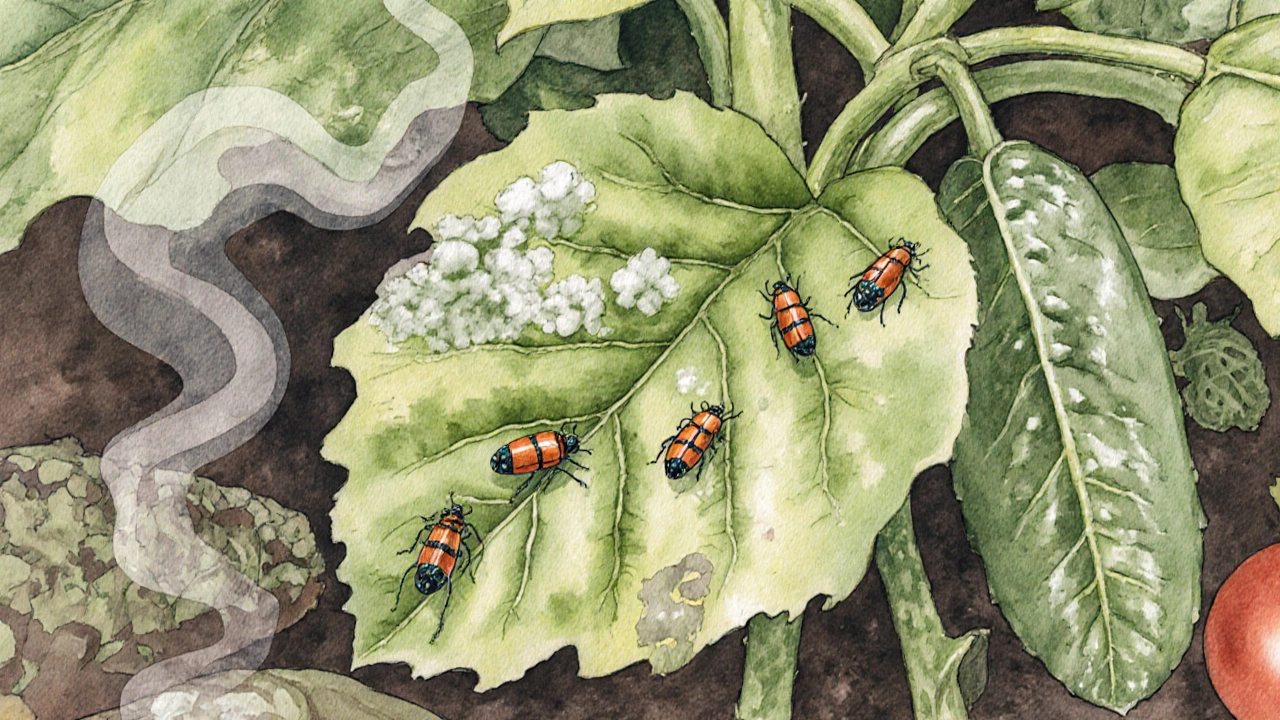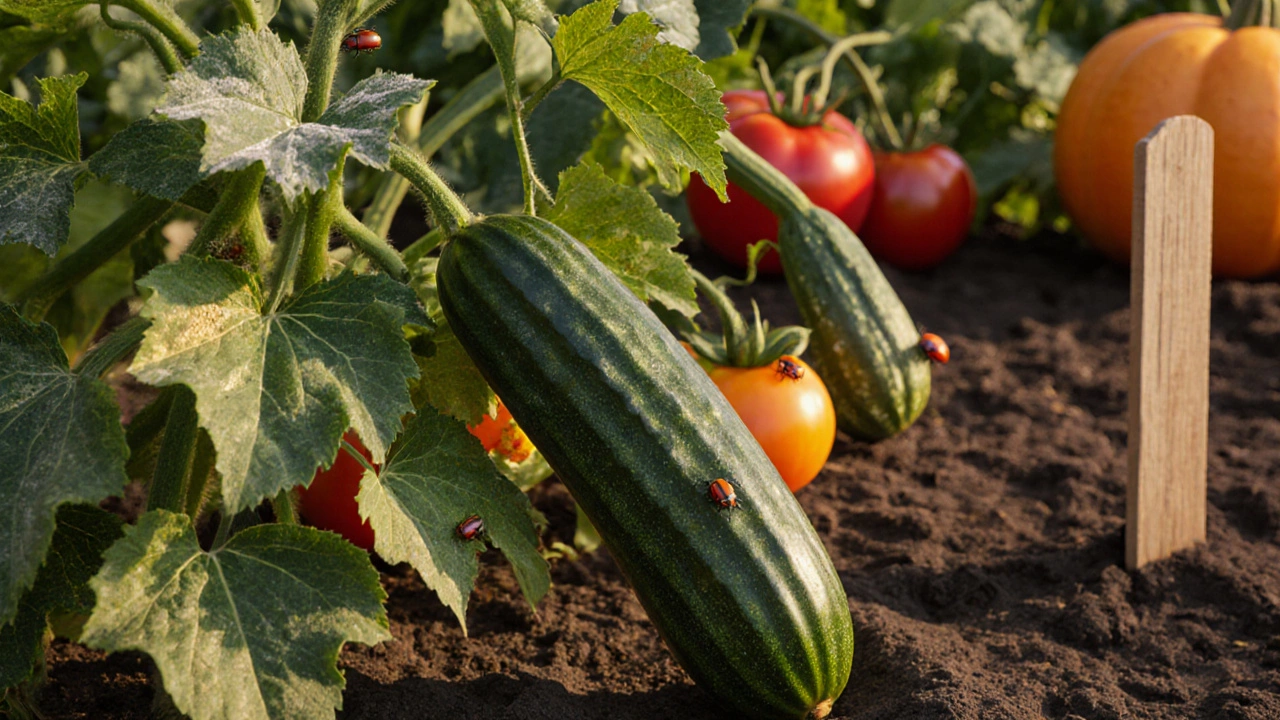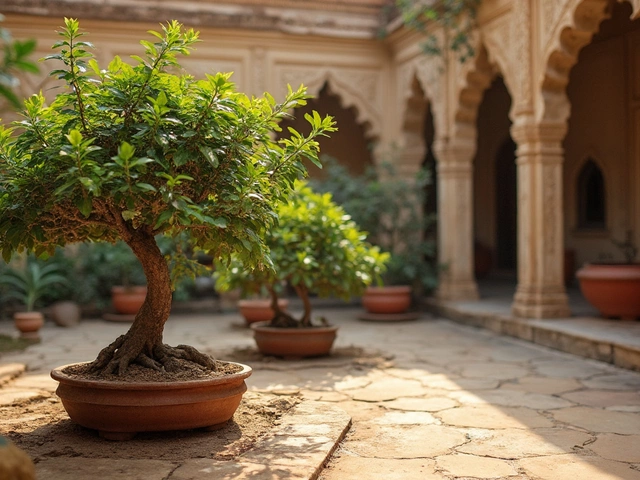Cucumber Companion Planting Checker
Check Your Plant Combination
Enter the name of a plant to see if it's a good or bad companion for cucumbers.
Enter a plant name and click "Check Companion" to see if it's a good or bad companion for cucumbers.
When you plan a vegetable bed, the choice of neighbors can make or break a cucumber harvest. Cucumber is a warm‑season vine that thrives on loose, well‑drained soil and plenty of sunlight. It also has a reputation for being picky about its companions. Plant the wrong neighbor and you’ll see stunted vines, increased disease pressure, or a sudden spike in pest numbers.
cucumber companion planting is the shortcut many gardeners use to boost yields, but knowing what NOT to plant nearby is just as crucial. Below you’ll find a practical guide that walks you through the classic offenders, why they cause trouble, and what to grow instead.
Why Companion Planting Matters for Cucumbers
Cucumbers belong to the Cucurbitaceae family, sharing many traits with melons, pumpkins, and gourds. This family produces similar chemicals that attract the same insects and fungi. When you mix family members, you essentially create a magnet for cucumber beetles, powdery mildew, and vine‑rot pathogens.
Beyond pest attraction, some plants release allelopathic compounds-natural chemicals that suppress the growth of nearby crops. Others compete aggressively for nutrients, water, or light, leaving cucumbers weak and more vulnerable.
Plants to Avoid Near Cucumbers
Here’s the short list of garden staples that should stay at least 3‑4 feet away from cucumber vines.
- Tomato - shares many fungal diseases such as early blight; also competes for nitrogen.
- Melon - same family, same pests; can cause rapid spread of cucumber beetles.
- Pumpkin - heavy water users; shade cucumber foliage leading to reduced fruit set.
- Corn - tall stalks cast shade; also attracts corn earworms that may jump to cucumbers.
- Watermelon - another cucurbit that shares cucumber wilt pathogens.
- Potato - can harbor Colorado potato beetle larvae that migrate to cucumber foliage.
- Sage - releases volatile oils that inhibit cucumber leaf expansion.

Deep Dive: How Each Plant Harms Cucumbers
Tomato
Tomatoes thrive in slightly acidic soil (pH 6.0‑6.8) while cucumbers prefer a near‑neutral range. Planting them together forces you to compromise on soil amendments, often leading to sub‑optimal conditions for both. Moreover, both crops are prone to Phytophthora root rot; shared moisture‑rich beds can quickly become a disease hotspot.
Melon & Watermelon
Melons and watermelons release cucurbitacins-bitter compounds that can suppress cucumber seed germination if seeds fall nearby. Their sprawling vines also create a dense canopy, limiting airflow and encouraging powdery mildew on cucumber leaves.
Pumpkin
Pumpkins are heavy feeders of potassium and phosphorus. In a limited‑space garden, they can strip these nutrients before cucumbers have a chance to absorb them, resulting in pale, spindly vines and fewer cucumbers per plant.
Corn
Besides casting shade, corn attracts the corn earworm (Helicoverpa zea). When earworms move between corn and cucumbers, they introduce bacterial wilt pathogens that are especially lethal to cucumbers.
Potato
Potatoes are a favorite host for the Colorado potato beetle. Young beetle larvae are curious and will feed on the tender undersides of cucumber leaves, causing skeletonized foliage and reduced photosynthesis.
Sage
Sage emits thujone, an essential oil that can stunt cucumber leaf expansion. While sage is a great herb for many vegetables, its volatile compounds interfere with cucumber cell elongation, leading to smaller leaves and lower yields.
Better Neighbors: Plants That Benefit Cucumbers
If you want to turn your bed into a cucumber haven, pair it with these proven allies.
- Radish - attracts beneficial nematodes that eat cucumber beetle larvae.
- Marigold - releases pyrrolizidine alkaloids that repel nematodes and some beetles.
- Beans - fix nitrogen, improving soil fertility for cucumber growth.
- Dill - attracts lady beetles and parasitic wasps that hunt aphids and cucumber beetles.
- Nasturtium - acts as a trap crop for aphids, keeping them off cucumbers.
Comparison Table: Bad vs. Good Companions
| Plant | Why Avoid / Benefit | Typical Issue / Help |
|---|---|---|
| Tomato | Shared fungal diseases, nutrient competition | Early blight, wilt, reduced nitrogen |
| Melon | Same family, attracts cucumber beetles | Powdery mildew, pest buildup |
| Pumpkin | Heavy potassium/phosphorus feeder | Stunted cucumber vines |
| Radish | Attracts beneficial nematodes | Reduces cucumber beetle larvae |
| Marigold | Releases nematode‑repelling oils | Suppresses soil‑borne pests |

Practical Tips for Managing Plant Relationships
- Map your garden. Sketch a layout and keep at least a 3‑foot buffer between cucumbers and any listed offender.
- Rotate crops annually. Move cucumbers to a different bed each season to break disease cycles.
- Use raised beds. Better drainage reduces the risk of root‑rot fungi that thrive when cucumbers sit next to water‑loving crops like pumpkins.
- Mulch wisely. Straw mulch keeps soil cool for cucumbers but can also harbor pests; inspect regularly.
- Monitor for pests. Sticky traps near the cucumber row catch early beetle flights before they spread from neighboring plants.
Checklist: Quick Reference Before Planting
- ✅ Keep tomatoes, melons, pumpkins, corn, watermelon, potatoes, and sage >4 ft away.
- ✅ Plant radishes, marigolds, beans, dill, and nasturtiums within 12 inches of cucumber vines.
- ✅ Test soil pH; aim for 6.2‑6.8 for optimal cucumber growth.
- ✅ Ensure at least 6 hours of direct sun per day.
- ✅ Space cucumber plants 12‑18 inches apart to improve airflow.
Frequently Asked Questions
Can I grow cucumbers and tomatoes in the same raised bed?
It’s best to avoid them together. Both crops like similar moisture, but tomatoes are heavy nitrogen feeders and share fungal diseases with cucumbers. If you must share a bed, keep a 4‑foot gap and use separate soil mixes.
Why do cucumbers wilt when planted next to corn?
Corn creates shade that reduces air circulation, encouraging bacterial wilt and fungal spores to settle on cucumber foliage. Additionally, corn attracts earworms that can vector wilt pathogens.
Is marigold a proven repel for cucumber beetles?
Marigold’s root exudates contain thiophenes, which deter many soil‑borne pests, including cucumber beetles. Planting a 6‑inch border works well as a biological barrier.
How far should I space radishes from cucumber vines?
Place radish seedlings 6‑12 inches away. They mature quickly, and their roots release compounds that attract nematodes which prey on cucumber beetle larvae.
Do potatoes really affect cucumber yield?
Potatoes can harbor Colorado potato beetles that move onto cucumber leaves. Moreover, both crops compete for deep soil moisture; when potatoes dominate, cucumbers often show yellowing and reduced fruit set.





